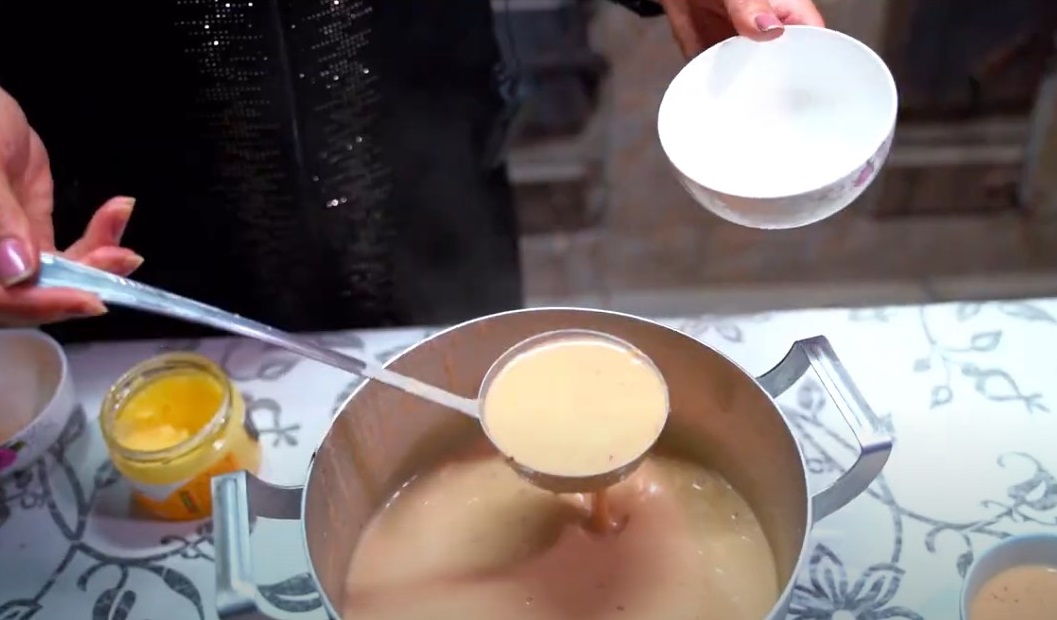
Kuurma Tea, a Kyrgyz stapleKyrgyzstan is a landlocked country in Central Asia, lying in the Tian Shan and Pamir mountain ranges. It is a Muslim country with a population of 7.2 million. Although geographically isolated by its highly mountainous terrain, Kyrgyzstan has been at the crossroads of several great civilizations as part of the Silk Road and other commercial routes.
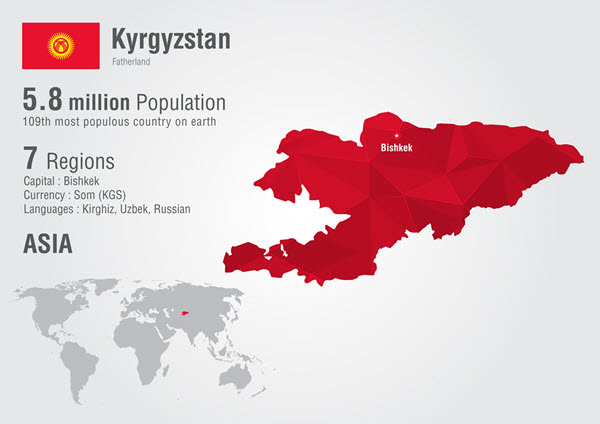 The spread of tea in Kyrgyzstan began in the 17th and 18th centuries when the Oirat rule was in full swing. Tea appeared in Kyrgyzstan thanks to the Great Silk Road, which traverses the Terskey Alatoo mountain range, from where it came to the Asian state. At that time, Kyrgyz people mainly drank green brick tea, which was crumbled, mixed with salt, milk, and flour, and fried in oil. The result was a rather nutritious brew, which was called kuurma-tea. This drink is still very popular in remote Kyrgyz villages, especially in snowy highland areas, where recharging your batteries and energy for the whole day is vital.
The spread of tea in Kyrgyzstan began in the 17th and 18th centuries when the Oirat rule was in full swing. Tea appeared in Kyrgyzstan thanks to the Great Silk Road, which traverses the Terskey Alatoo mountain range, from where it came to the Asian state. At that time, Kyrgyz people mainly drank green brick tea, which was crumbled, mixed with salt, milk, and flour, and fried in oil. The result was a rather nutritious brew, which was called kuurma-tea. This drink is still very popular in remote Kyrgyz villages, especially in snowy highland areas, where recharging your batteries and energy for the whole day is vital.
Milk, sprouted wheat, and fried flour are added to kuurma-tea. Depending on preferences, salt or sugar is added to the finished drink. It is customary to drink such tea as a preventative measure against colds.
It’s the same with Aktyn tea. This is a strong-brewed black tea boiled with milk, melted butter, salt, and sour cream.
Roasted tea is a traditional dish prepared by frying flour in oil, adding milk, water, and thick brewed tea. In folk medicine, roasted tea is used as a stimulant food.
Due to the strong influence of Russia, black tea entered the Kyrgyz culture. Today, both black tea and green tea are equally popular in Kyrgyzstan. “Tell me how you drink tea, and I will tell you who you are” – this is how one can characterize the peculiarities of tea drinking in Kyrgyzstan. The most favorite drink in Kyrgyzstan is tea. Tea is drunk at home, at a party, and in a teahouse – all year round. Any feast, whether a birthday, wedding, or anniversary, begins and ends with tea.
Atkanchay translates as “prepared tea.” It is a mixture of tea, salt, and milk. In some regions, butter or sour cream is added and sprinkled with sesame seeds. This hearty drink is usually served for breakfast.
Maksym is a sour drink made from barley, wheat, millet, and corn, and it has become the national drink of modern Kyrgyzstan. Chalap (tan) is ayran diluted with water. If you mix maksym and chalap, you get a drink called aralash.
In Kyrgyzstan, there are two more drinks that adults drink. Bozo is made from millet, corn, or millet and yeast. It has a slight alcohol content (4-6%) and a sweetish taste. Dzarma (zharma) is a barley drink with a slight alcohol content.
By the way, the Mongols, Tibetans, Kalmyks, Buryats, and other ethnic groups, culturally and mentally close to the Kyrgyz, have something similar.
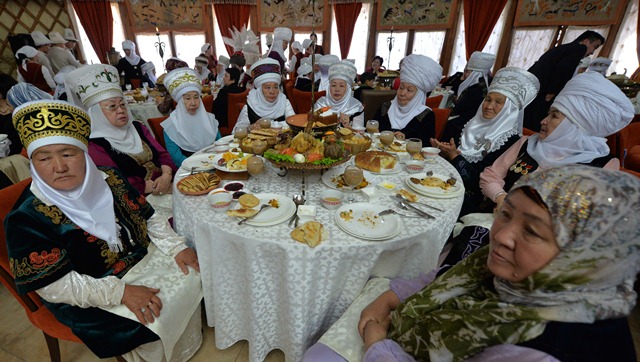
Tea Geography
Different Kyrgyz teas are consumed in different geographical parts of the Kyrgyz Republic. Southerners living in the Jalal-Abad, Batken, and Osh regions like green, while in the north, they drink black (sometimes with milk). Drinking green tea along with black tea is very common in the South. They usually prefer tart green tea, which is brewed in porcelain pot-bellied teapots, preheated, preferably on charcoal, and then acquires an additional aroma.
As strange as it may sound, it is scalding hot tea that helps to escape the scorching summer heat typical for the southern regions of Kyrgyzstan. They drink tea leisurely, during sedate conversations – without sugar or other additives. When guests arrive, the host himself pours the tea. He pours the bright golden drink into small bowls to only slightly cover the bottom. It is believed that the less tea they pour you, the more respect you receive.
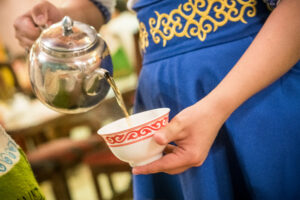 But in the north of the country – in the Talas and Naryn regions – they prefer strong black tea, the water for which is boiled in samovars (Kyrgyz interpretation is samoor). Here, kumsheker (lump sugar) and fatty homemade milk are added to the tea and sometimes butter. And the kelin (daughter-in-law) pours it. If the family has not yet acquired a daughter-in-law, then the youngest girl (or even a girl – the main thing is that she can already hold a teapot in her hands) will bring tea to the guests.
But in the north of the country – in the Talas and Naryn regions – they prefer strong black tea, the water for which is boiled in samovars (Kyrgyz interpretation is samoor). Here, kumsheker (lump sugar) and fatty homemade milk are added to the tea and sometimes butter. And the kelin (daughter-in-law) pours it. If the family has not yet acquired a daughter-in-law, then the youngest girl (or even a girl – the main thing is that she can already hold a teapot in her hands) will bring tea to the guests.
In Issyk-Kul and Naryn, they treat people to tea with homemade fatty milk and lump sugar. And in all regions of the country, they like tea with salt. In south Kyrgyzstan, tea is served in small bowls to keep it hot. In Talas and Naryn, boiling water for tea in samovars is customary.
And in Issyk-Kul, tea is poured into large chynas (bowl-like cups), often handmade. In short, tea accompanies all Kyrgyzstanis without exception throughout their lives. It is served at weddings, christenings, funerals, wakes, etc. And, of course, it is an obligatory element of hospitality. In any house in the country, any person – an old friend or a barely familiar guest – will definitely be poured a cup of hot, fresh, aromatic tea. It will be served with dried fruits, boorsoks, melted butter, sour cream and jam.
In the north, many people drink milk tea or add milk to tea. According to Isa Kylychbek, founder of the “Bayhan” tea brand in Kyrgyzstan, black tea is the most sold in the Kyrgyz market. Every Kyrgyz citizen drinks an average of 1.5 kg of tea per year.
In different regions of Kyrgyzstan, tea with honey and navat, dried apricots and raisins, rose hips and sea buckthorn, mint and apples, lemon and raspberries, balms and herbs, etc., are still savored.
- According to official statistics, from January to July of this year, 5,638 tons of tea worth $6.2 million were imported to Kyrgyzstan. It is noted that tea imports increased by 14% compared to January-July 2023. Kyrgyzstan imported the most tea from Kazakhstan – 4,277 tons worth $2.3 million. In addition, tea was imported from Russia (350.4 tons), Sri Lanka (300.5 tons), China (286 tons), and Pakistan (105 tons). The other minor suppliers were Kenya, Iran, Turkey, and Vietnam.
Fatty meat food weakens the tone of the digestive tract, and hot tea is simply irreplaceable here. It speeds up digestion and helps with intestinal disorders common in Asia. It also absorbs and removes harmful substances from the body. That is, Kyrgyz ancestors already understood in ancient times that tea is the best “dry cleaning” for the stomach, kidneys, and liver!
By the way, now it is customary to drink tea in Kyrgyzstan not only black and green. Young people prefer a hot drink with lemon, cloves, wild strawberries, and strawberries.
Teahouses
Tea is drunk everywhere in Kyrgyzstan, but there are special places where Kyrgyz tea is served – teahouses. A teahouse is a place where residents gather to drink delicious tea, discuss news, and chat with friends. Kyrgyz teahouses are usually decorated with large carpets, on which it is customary to sit, as well as dastarkhans (low dining tables).
Teahouses in Kyrgyzstan are usually located outdoors, so visitors can enjoy hot, delicious tea, fresh air, picturesque nature, and musicians, who are often invited to teahouses. If you decide to visit a Kyrgyz teahouse, first of all, you should take off your shoes and lie down on the carpet near the dastarkhan, on which there is a bowl and a teapot with aromatic hot tea. You can spend the whole day in a teahouse because time flies unnoticed over a cup of good tea and friendly conversations.
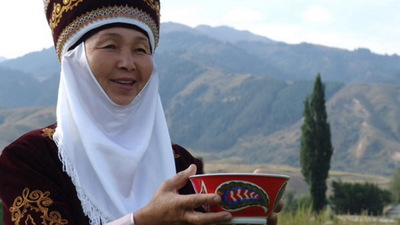 If you are invited to visit, know that you will not be able to leave hungry. At the beginning of the feast, pastries, sweets, nuts, fruits, salads, and vegetables are served. After that, the main course is placed on the table, and the final course is tea in a beautifully painted bowl according to a special Kyrgyz recipe.
If you are invited to visit, know that you will not be able to leave hungry. At the beginning of the feast, pastries, sweets, nuts, fruits, salads, and vegetables are served. After that, the main course is placed on the table, and the final course is tea in a beautifully painted bowl according to a special Kyrgyz recipe.
As the Kyrgyz themselves say: “What could be better than a cup of tea in those moments when the stomach is full, and the head is empty.”
Photos courtesy Kyrgyzfriends
Tea Market
Get More Value from Your Tea: BRU Maker One
+41794574278
Jacque's Organics
(647) 804-7263
This is a precious story about Kyrgyzstan’s tea culture. It is information that could not be found in books until now. We can recognize the various tea culture contents of Kyrgyzstan through actual experience, and from that recognition, we find facts about tea. When those facts are collected, they become information. That information can be developed into knowledge, theory, and discipline. This kind of discipline about tea is Teaics. Kyrgyzstan’s tea culture theory. I hope it will be concretized as a tea knowledge theory of the Kyrgyz region. I welcome the introduction of a new tea theory that has not been revealed.
Such efforts lay the groundwork for a theoretical framework dedicated to Kyrgyz tea culture. I fully support the development of this discipline, which has the potential to enrich global understanding of tea cultures by bringing Kyrgyzstan’s unique contributions into focus.